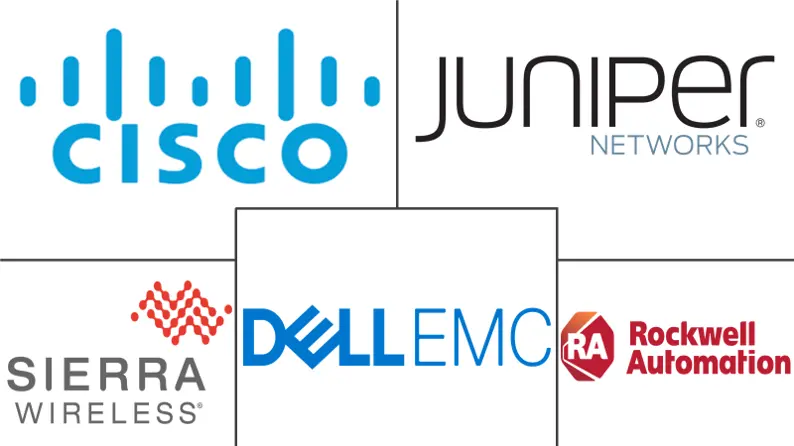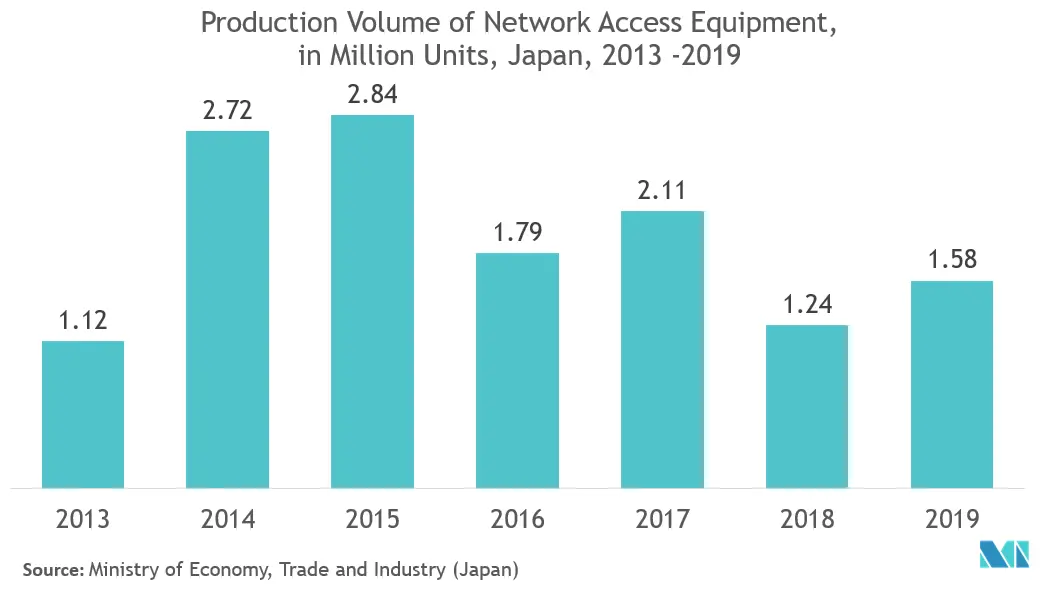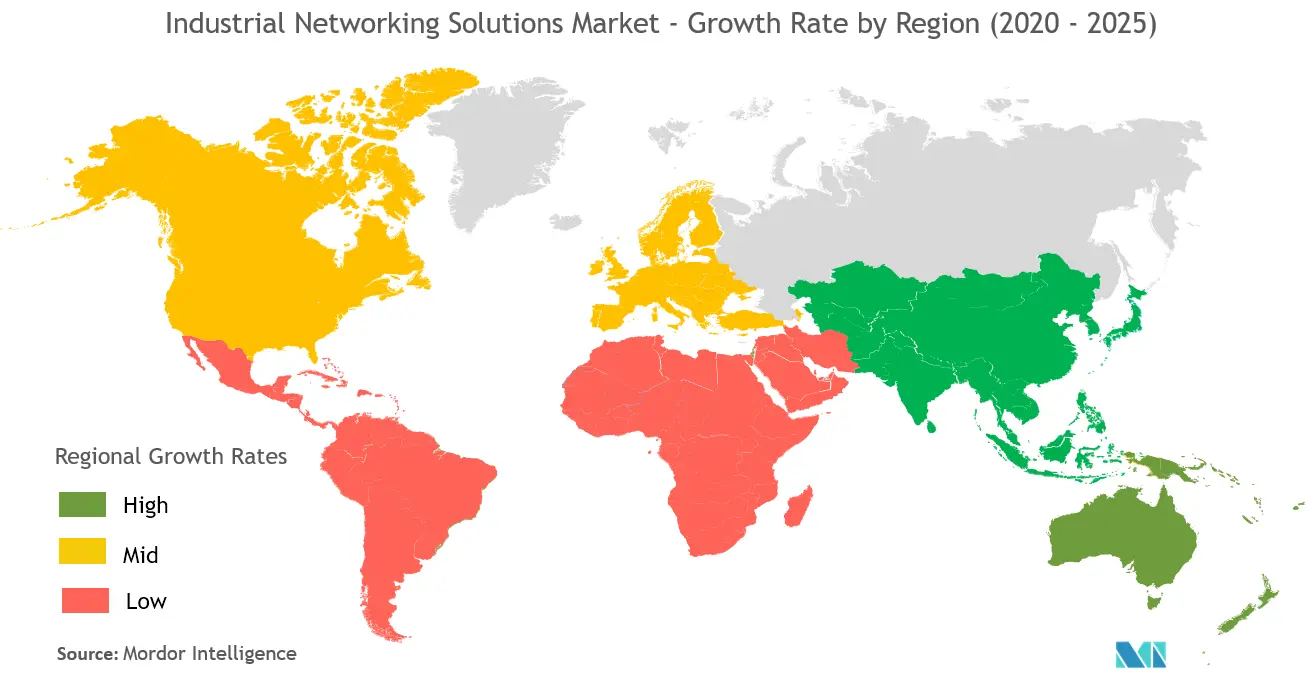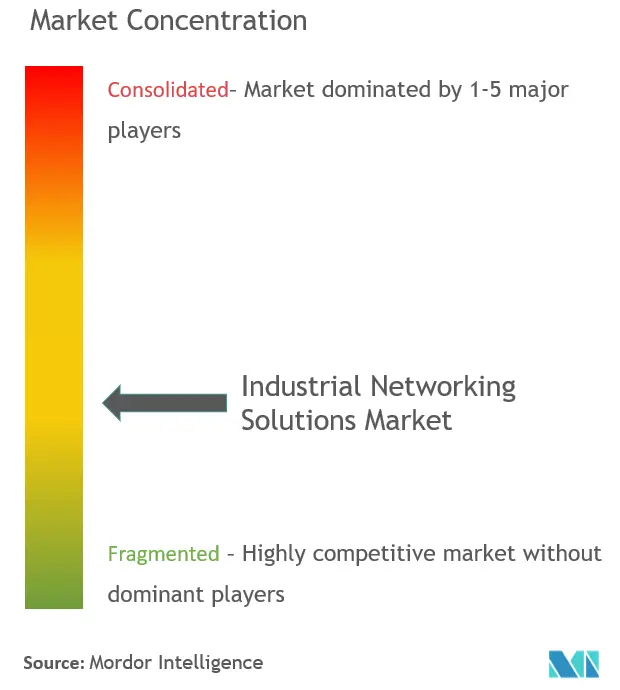Industrial Networking Solutions Market Size

| Study Period | 2019 - 2029 |
| Base Year For Estimation | 2023 |
| CAGR | 20.34 % |
| Fastest Growing Market | Asia Pacific |
| Largest Market | North America |
| Market Concentration | Low |
Major Players
*Disclaimer: Major Players sorted in no particular order |
Industrial Networking Solutions Market Analysis
The Industrial Networking Solutions Market is expected to register a CAGR of 20.34% over the forecast period from 2021 - 2026. Multiple industries are seeking to drive operational improvements into their assets and production systems with the help of convergence and digitization by utilizing the new solutions in the Industrial Internet of Things (IIoT) and Industry 4.0. However, these initiatives have the requirement to securely connect the production environments with standard networking technologies to allow industries and their key partners access to a rich stream of new data, real-time visibility, and remote access to the systems and assets in the operational environments. This is the right time for Industry 4.0 since many industrial applications and digitalization efforts can benefit today from LTE/4G; besides, it is a vital step to promote the adoption of cellular technology at industrial verticals and lay the foundation for future advanced networking use cases.
- The industrial ecosystem is moving away from Fieldbus technologies based on proprietary networks for communication protocols over standard networking such as Ethernet, 802.11-based Wi-Fi, and the portfolio of I.P. protocols (for example, TCP and UDP). This focus on open networking standards is a foundational aspect of the devices that make up the industrial ecosystem are capable of communicating on converged, public networks, which significantly improves the accessibility of data and information. Also, there are many emerging network technologies currently being discussed or developed in the industry. Technologies such as Network Slicing (part of 5G), Software Defined Networking (SDN), Network Function Virtualization (NFV), and Low Power Wide Area Network (LPWAN) may provide better or different support for industrial applications.
- The industries are witnessing humongous growth in data generation, due to mobile and connected devices, cloud-based systems, etc. With more than 50 billion connected devices expected, Huawei predicts that, by 2020, over 50% of data may be analyzed, processed, and stored at the network edge. Moreover, according to Cisco, 46% of network devices will be machine -to -machine or IoT by 2020, which are vulnerable to attacks. To fully realize the potential of these connected devices, the industries need to be equipped with Wide Area Networks that are flexible to meet the network demands anticipated over the future.
- In January 2020, NXP Semiconductors N.V. announced a multi-gigabit Ethernet switch designed for automakers to deliver the high-speed networks required for evolving connected vehicles. The NXP SJA1110 is one of the first automotive Ethernet switches with built-in safety capabilities, offering integrated hardware-assisted security, and multi-gigabit interfaces. Optimized for integration with NXP's S32G vehicle network processor, the SJA1110 switch is also an integral part of an overall networking solution, which includes the VR5510 power management I.C. Together, this solution is designed to address some of the biggest challenges facing vehicle networking including scalability, security, safety, and high-speed traffic engineering.
- In November 2019, Nokia announced that it had launched private wireless networks for more than a hundred customers across multiple industries where it's industrial customers can take advantage of these networks related to Industry 4.0 innovation. Unleashing the full potential of Industry 4.0 technologies such as machine learning, A.I., cloud, and IoT Nokia's private LTE/4.9G, and 5G wireless networking solutions have established a global marketplace footprint across energy, public sector, manufacturing, transportation, and logistics. Building on this marketplace's success, Nokia also announced an expansion of its industrial-grade private networking solutions.
- The outbreak of COVID-19 is expected to influence global industrial spending significantly over the coming years due to the non-operational status of various industries deemed non-essential by governments across the world are facing huge losses that are expected to influence their tech spending till the end of 2021. Moreover, COVID-19 is forcing various manufacturers to depend more on digitalization and automation for long-term operations to reduce the financial impact of the pandemic and other potential economic challenges. COVID-19 outbreak is expected to be a short-term effect, and it would eventually pass. However, in the long run, COVID-19 is a chance for industries to make much-needed operational improvements with significant emphasis on enhancing networking technologies increases amidst the current pandemic.
Industrial Networking Solutions Market Trends
This section covers the major market trends shaping the Industrial Networking Solutions Market according to our research experts:
Manufacturing is Expected to Hold Significant Share
- Manufacturing undergoes improvement and optimization programs throughout the lifecycle of the products being manufactured. The trend is that the process improvements need to be performed quite frequently and nearly continuously in some cases. More and more IIoT sensors are being added to the existing operations to achieve more efficient process improvement. For instance, the U.S. Food and Drug Administration (FDA) has guided manufacturers to adopt a risk-based approach to meeting product quality and regulatory requirements through Process Analytic Technology (PAT). A core part of PAT is continuous inline monitoring of the process that engages in transforming the raw materials into end products. This monitoring technique requires additional instruments and sensors for the process, and the new sensors will require industrial networks to communicate with the control systems.
- In today’s digitally-driven manufacturing environments, there are many sensors and devices and too much data to depend on manual processes. There is an increasing need for manufacturing organizations to automate the monitoring of systems across the factory floor and their responses to abnormal conditions, such as equipment showing signs of stress. Because most industrial operations have been taking place for a long time, the sensors need to be retrofitted onto existing machinery, which can be done efficiently with wireless communication technologies. Wireless mesh networks using technologies such as Bluetooth LE mesh and IEEE 802.15.4 and will provide the edge connectivity to such sensors. Wired sensors will be relevant and can even migrate from dedicated Fieldbus technologies to variants of industrial Ethernet, including single-pair Ethernet networks.
- Mass customization in manufacturing has caused a drastic shift in assembly plants. Modern assembly logistics and lines need to be agile and flexible to manage the required product variability without compromising quality. To support flexible manufacturing, the network should have the ability to self re-configure dynamically. To maintain the highest production level in manufacturing, machine maintenance needs to take place during scheduled downtime. This is effective when machines can predict when and where faults are about to happen to be serviced then. This collected data needs to be communicated across multiple industrial networks for analysis such that it could also be used for machine learning and for conducting business intelligence.
- In June 2020, Veracity Industrial Networks, a developer of Industrial Software Defined Network (SDN)-based technology for operational networks announced a new seed round of funding, backed by existing investors Schweitzer Engineering Laboratories (SEL) and Option3Ventures, with the latest strategic investments from DYNICS, Inc. and Interstates, Inc. The companies introduced the Veracity Industrial Network Controller to their customers in the Manufacturing, Automotive, and Process Automation markets. Industrial control systems are increasingly becoming vulnerable to cyber-attack, and manufacturing companies are looking forward to their suppliers and integration partners to strengthen their control system’s network defenses.

Asia Pacific is Expected to Witness Fastest Growth
- Asia-Pacific is expected to witness the fastest growth during the forecast period, owing to the rapid development of the network infrastructure. Moreover, this region has seen robust initiatives to upsurge the industrial networking infrastructure in different countries. Backed by positive and proactive government support, China is betting big on the IIoT and, being one of the world's largest economies, operators as well as other vendors in the ecosystem, are helping to accelerate the delivery of compelling and secure industrial networking solutions including Low Power Wide Area networks, such as NB-IoT and LTE-M, which are helping to usher in innovative new services across China.
- The Japanese government launched a 5G spectrum designated for industries and local governments at the end of 2019. This will enable industries, organizations, and other regional authorities in Japan to utilize the next-generation of industrial-strength wireless connectivity, which is based on LTE and 5G technologies to create local reliable, private networks. In November 2019, Nokia and Hitachi Kokusai Electric formed a collaboration to provide an ecosystem of solutions to support the deployment of the latest digital automation services. Hitachi Kokusai Electric will provide its expertise in driving private LTE networks' usage for industry use and disaster prevention in Japan.
- In July 2019, Hewlett Packard Enterprise (HPE) announced it plans to invest USD 500 million in India over the next five years, increase its workforce by 20% over the next 3-5 years, and start manufacturing in India end of 2019. The company is scheduled to begin making Aruba's (unit of HPE) portfolio of mobility and IoT solutions in India before 2019. Data and connectivity are the major catalysts for growth in India, and Aruba's substantial intellectual property and mobile-first philosophy will make it ideal for making this growth. The manufacturing capability in India will make Aruba innovate in the industrial networking segment that will deliver several benefits in the Digital India agenda and to various industries across the country.
- In April 2020, ZTE Corporation deployed the core router single servers and network clusters for China Telecom in Jinzhou, Liaoning province, and Ganzhou, Jiangxi province, despite the trouble in transportation, supplies, and dispatching brought by the COVID -19 outbreak. ZTE's devices maintained the stable and efficient running of the complete network, offering a guarantee to the extensive -traffic communication services with increasing users. This product has been deployed in around 19 provinces in China and is broadly applied in overseas markets, including Ethiopia, Indonesia, and Malaysia. It will be further deployed in Guangdong, Guangxi, Jiangxi, Liaoning, and Hubei provinces by China Telecom.

Industrial Networking Solutions Industry Overview
The industrial networking solutions market is fragmented as the market consists of significant players, which include Cisco Systems, Inc., Juniper Networks, Inc., Dell EMC (Dell Technologies Inc.), Sierra Wireless, Inc., etc. The companies operating in the market continuously strive to launch new solutions for industries that ensure seamless network connectivity and are also forming mergers and partnerships to increase their presence.
- April 2020 - Cisco announced the intent to acquire privately-held Fluidmesh Networks, a provider wireless backhaul system. Fluidmesh will further extend Cisco's industrial wireless networking offerings to industries with moving assets and applications in situations where reliable backhaul is mission-critical. Cisco's scale, coupled with Fluidmesh's solution-based offerings and relationships with systems integrators, will accelerate Cisco's IIoT business to enable successful industrial wireless networking deployments and widen its reach to various partners and end-users.
- May 2020 - Dell Technologies announced Enterprise SONiC Distribution by Dell Technologies, a new set of fully supported open-source networking solutions. As industries are increasingly relying on modern hybrid cloud models to do business, the historically monolithic and proprietary approach to networking has created inefficiencies and unneeded complexity. Dell Technologies is building off the work Microsoft Corporation spearheaded as part of the Software for Open Networking in the Cloud (SONiC) open-source project.
Industrial Networking Solutions Market Leaders
-
Cisco Systems Inc.
-
Juniper Networks Inc.
-
Dell EMC (Dell Technologies Inc.)
-
Rockwell Automation, Inc.
-
Sierra Wireless, Inc.
*Disclaimer: Major Players sorted in no particular order

Industrial Networking Solutions Market Report - Table of Contents
1. INTRODUCTION
- 1.1 Study Assumptions and Market Definition
- 1.2 Scope of the Study
2. RESEARCH METHODOLOGY
3. EXECUTIVE SUMMARY
4. MARKET INSIGHTS
- 4.1 Market Overview (Covers the impact due to COVID-19)
- 4.2 Industry Value Chain Analysis
-
4.3 Industry Attractiveness - Porter's Five Forces Analysis
- 4.3.1 Bargaining Power of Suppliers
- 4.3.2 Bargaining Power of Consumers
- 4.3.3 Threat of New Entrants
- 4.3.4 Threat of Substitute Products
- 4.3.5 Intensity of Competitive Rivalry
5. MARKET DYNAMICS
-
5.1 Market Drivers
- 5.1.1 Increase in the usage of Wireless Networks across the Industry Operations
- 5.1.2 Rising Demand For Software Defined Wide Area Network
-
5.2 Market Restraints
- 5.2.1 Concerns Related to Data Privacy and Security
6. TECHNOLOGY SNAPSHOT
- 6.1 Software-Defined Wide Area Network (SD-WAN)
- 6.2 Wireless Local Area Network (WLAN)
- 6.3 Other Networking Solutions Technology
7. MARKET SEGMENTATION
-
7.1 By Component
- 7.1.1 Hardware
- 7.1.2 Software and Services
-
7.2 By Type of Connectivity
- 7.2.1 Wired
- 7.2.2 Wireless
-
7.3 By Deployment Type
- 7.3.1 On-premises
- 7.3.2 Cloud
-
7.4 By End-User Industry
- 7.4.1 Automotive
- 7.4.2 Financial and Banking Industry
- 7.4.3 Manufacturing
- 7.4.4 Telecommunication
- 7.4.5 Logistics and Transportation
- 7.4.6 Other End-User Industries (Mining, Oil and Gas, Energy and Utilities etc.)
-
7.5 Geography
- 7.5.1 North America
- 7.5.2 Europe
- 7.5.3 Asia-Pacific
- 7.5.4 Rest of World
8. COMPETITIVE LANDSCAPE
-
8.1 Company Profiles*
- 8.1.1 Cisco Systems, Inc.
- 8.1.2 Juniper Networks, Inc.
- 8.1.3 Dell EMC (Dell Technologies Inc.)
- 8.1.4 Rockwell Automation, Inc.
- 8.1.5 Sierra Wireless, Inc.
- 8.1.6 Huawei Technologies Co. Ltd
- 8.1.7 Aruba Networks HPE
- 8.1.8 Eaton Corporation
- 8.1.9 Nokia Corporation
- 8.1.10 ABB Ltd
- 8.1.11 Hirschmann (Belden Inc.)
- 8.1.12 Moxa Inc.
- 8.1.13 Red Lion Controls, Inc. (Spectris PLC)
- 8.1.14 Antaira Technologies
9. INVESTMENT ANALYSIS
10. FUTURE OF THE MARKET
** Subject To AvailablityIndustrial Networking Solutions Industry Segmentation
An industrial network solution is an essential part of any automation system architecture as it engages in providing effective means of data exchange and data controllability and flexibility to connect several devices. Generally, communication networks are utilized to enable data communication between computers and other devices. These networks are used in the distribution of multiple products, offer technical support, which needs to be wired and wireless networking systems.
| By Component | Hardware |
| Software and Services | |
| By Type of Connectivity | Wired |
| Wireless | |
| By Deployment Type | On-premises |
| Cloud | |
| By End-User Industry | Automotive |
| Financial and Banking Industry | |
| Manufacturing | |
| Telecommunication | |
| Logistics and Transportation | |
| Other End-User Industries (Mining, Oil and Gas, Energy and Utilities etc.) | |
| Geography | North America |
| Europe | |
| Asia-Pacific | |
| Rest of World |
Industrial Networking Solutions Market Research FAQs
What is the current Industrial Networking Solutions Market size?
The Industrial Networking Solutions Market is projected to register a CAGR of 20.34% during the forecast period (2024-2029)
Who are the key players in Industrial Networking Solutions Market?
Cisco Systems Inc., Juniper Networks Inc., Dell EMC (Dell Technologies Inc.), Rockwell Automation, Inc. and Sierra Wireless, Inc. are the major companies operating in the Industrial Networking Solutions Market.
Which is the fastest growing region in Industrial Networking Solutions Market?
Asia Pacific is estimated to grow at the highest CAGR over the forecast period (2024-2029).
Which region has the biggest share in Industrial Networking Solutions Market?
In 2024, the North America accounts for the largest market share in Industrial Networking Solutions Market.
What years does this Industrial Networking Solutions Market cover?
The report covers the Industrial Networking Solutions Market historical market size for years: 2019, 2020, 2021, 2022 and 2023. The report also forecasts the Industrial Networking Solutions Market size for years: 2024, 2025, 2026, 2027, 2028 and 2029.
Industrial Networking Solutions Industry Report
Statistics for the 2023 Industrial Networking Solutions market share, size and revenue growth rate, created by Mordor Intelligence™ Industry Reports. Industrial Networking Solutions analysis includes a market forecast outlook to 2029 and historical overview. Get a sample of this industry analysis as a free report PDF download.



